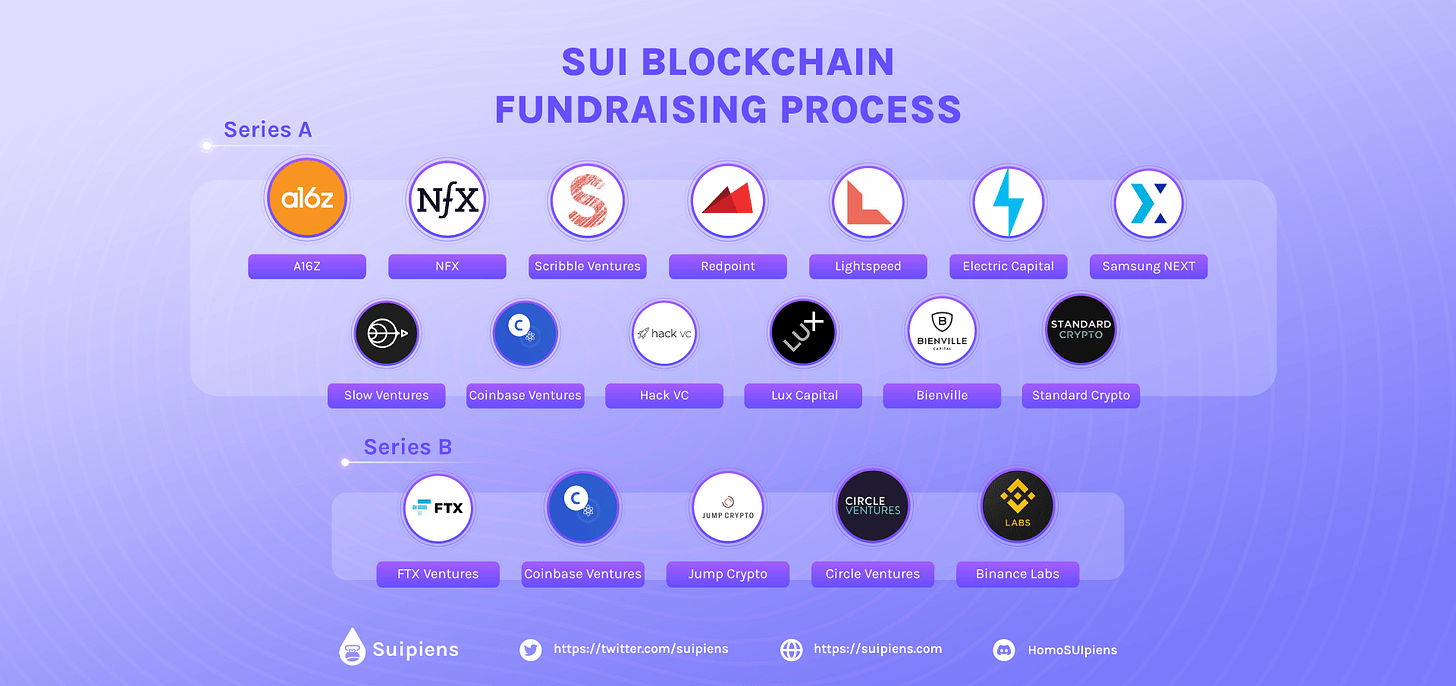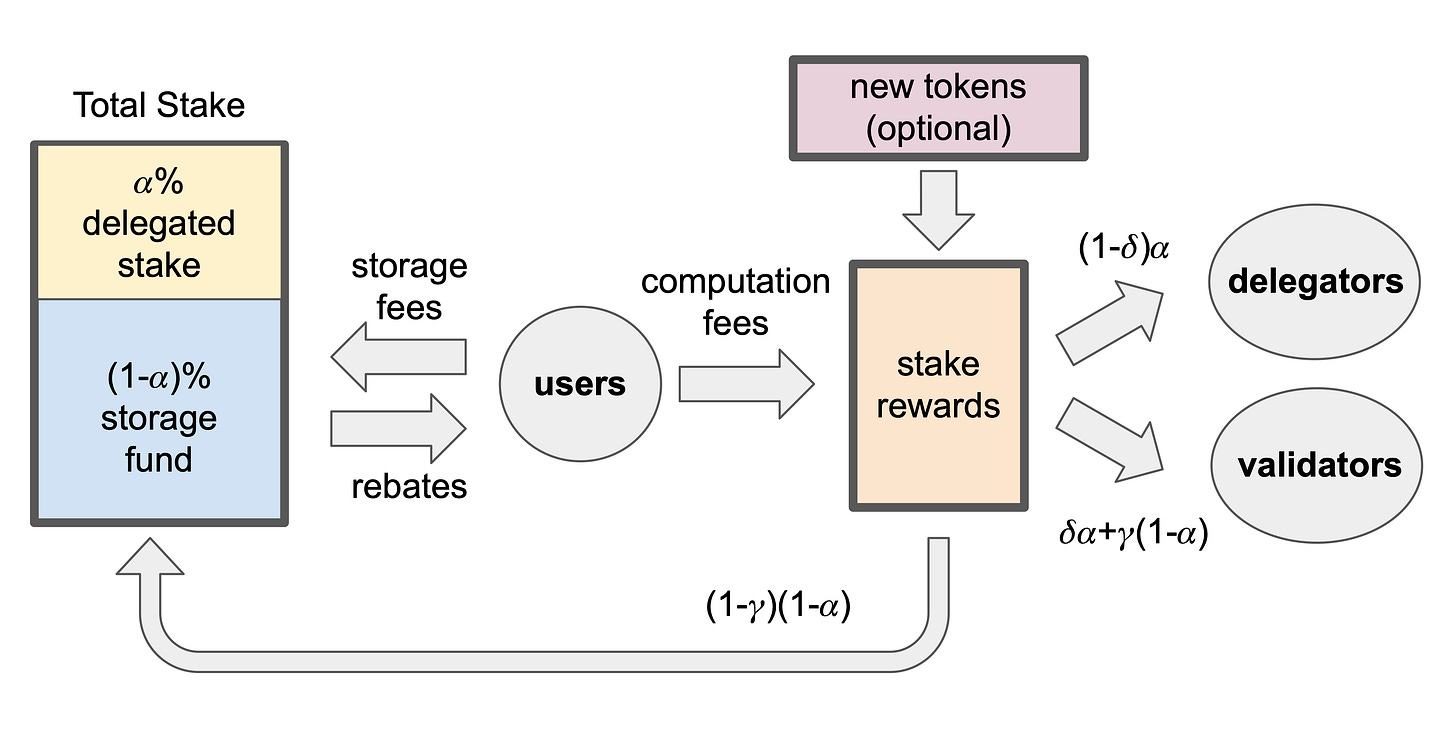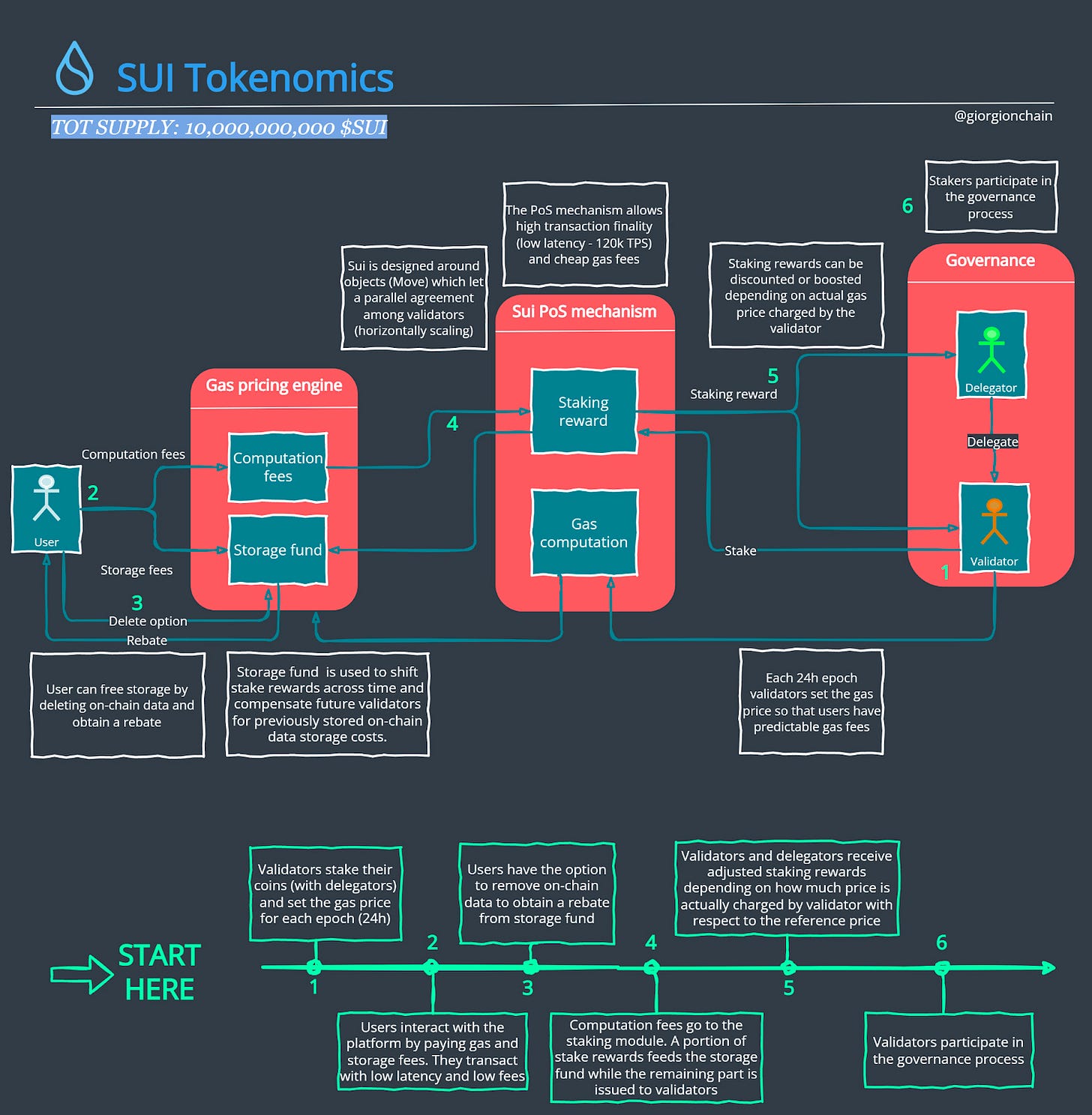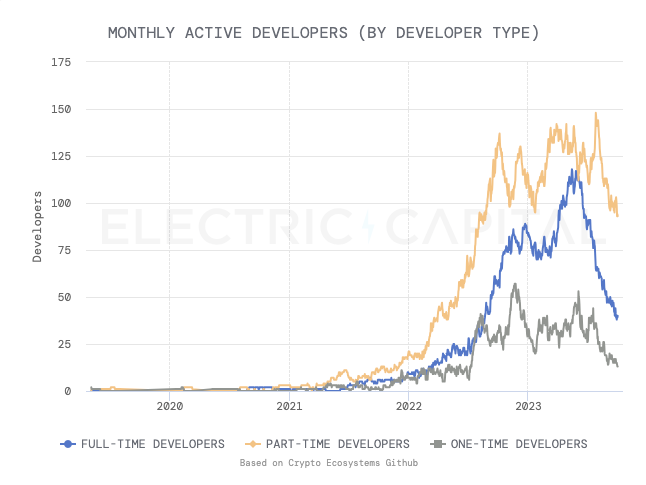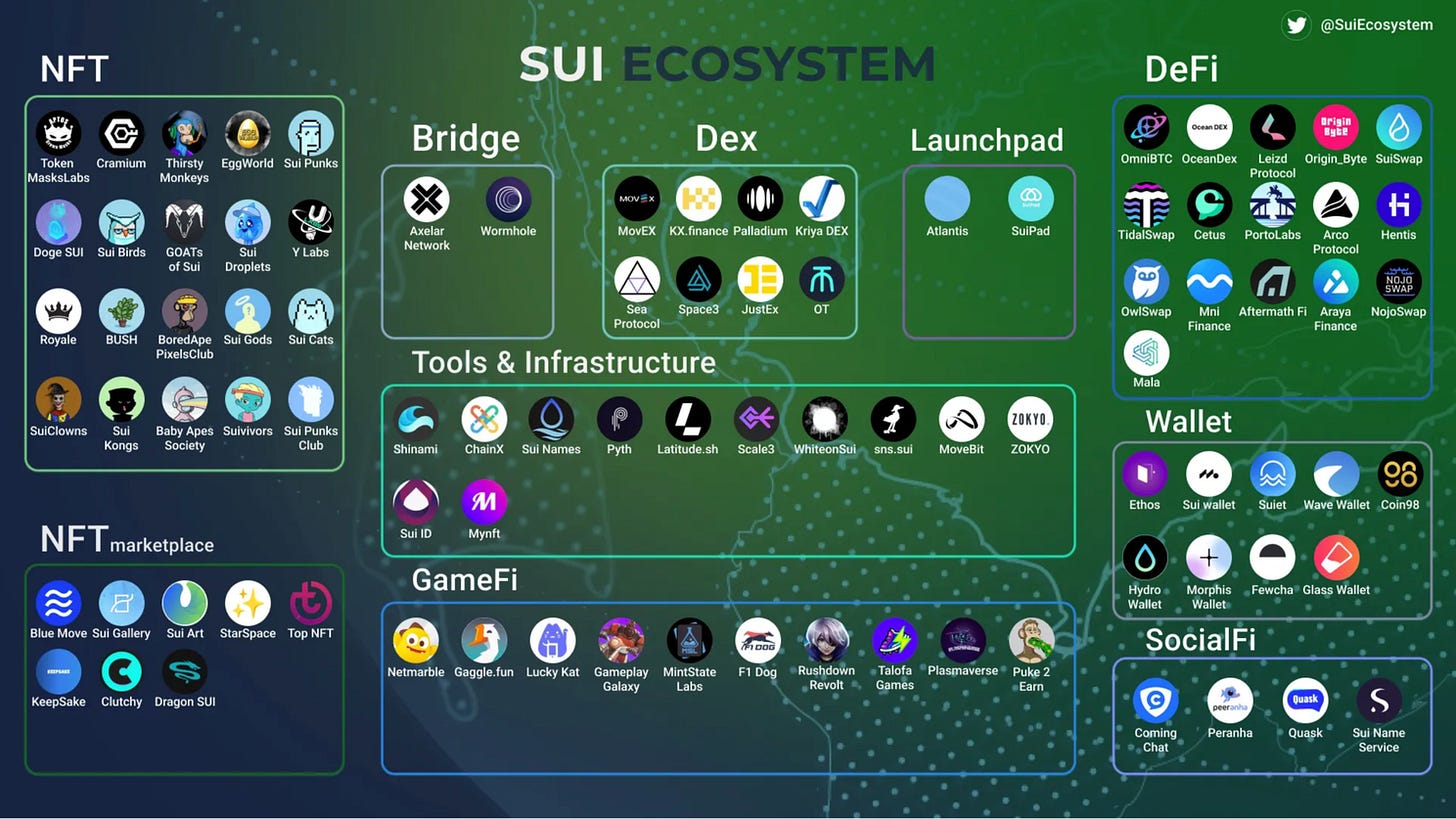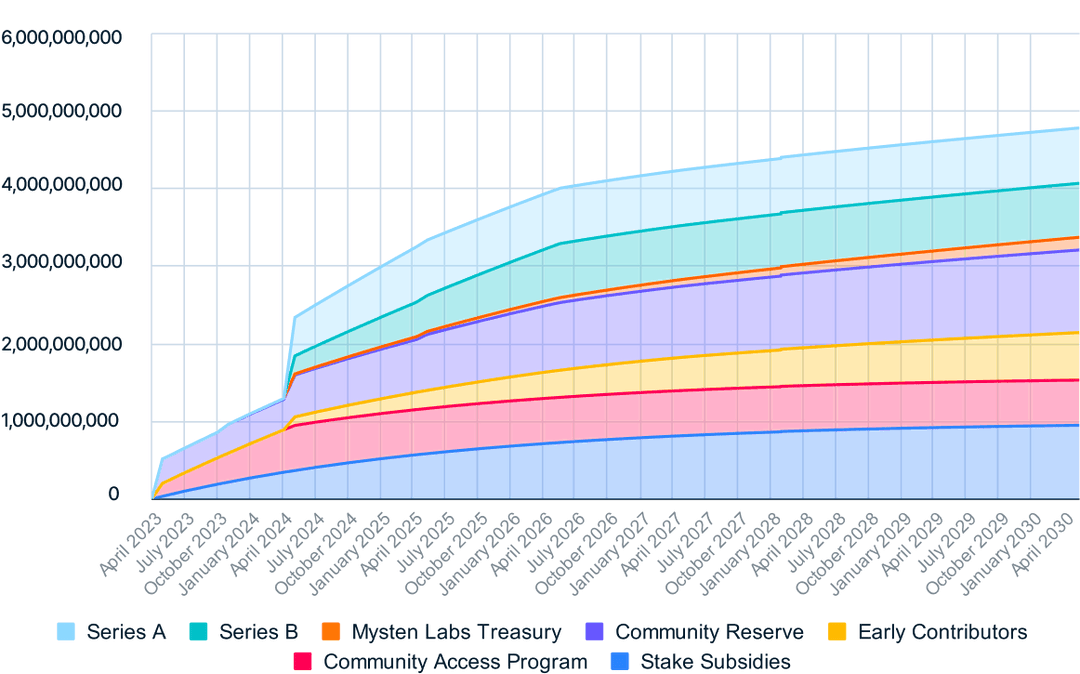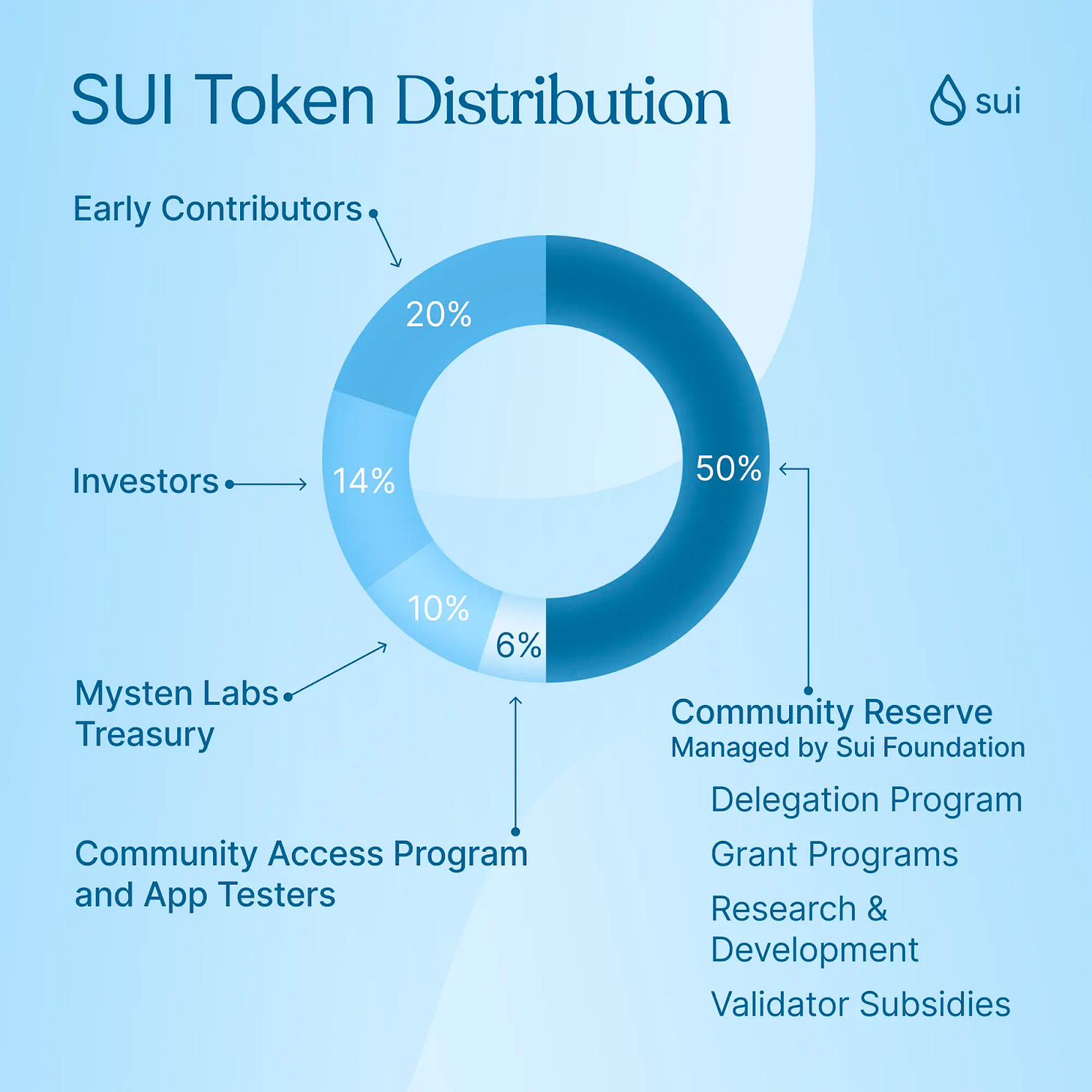Cryptopedia #1 - Sui
All you need to know about Sui - founding team, fundraising, data model, tokenomics and the market sentiment (alt., you may jump to part 6 for my quick take)
1. Founding Team
Prior to the creation of Mysten Labs / Sui Foundation, all co-founders worked at Novi —Meta’s digital wallet, which, alongside Diem (aka Libra) cryptocurrency, were all shut down in 2022, reportedly due to regulatory pressure. Sui’s co-founders are:
Evan Cheng, CEO: former Head of Research and Development at Novi and Technical Director of Meta. Previously, he worked at Apple for 10 years;
Sam Blackshear, CTO: Former Chief Engineer at Novi, specialising in the Move programming language;
Adeniyi Abiodun, CPO: Former Head of Product Development at Novi, Meta. Previously worked at VMware, Oracle, PeerNova, HSBC, JP Morgan;
Danezis, Chief Scientist: Former researcher at Novi, Meta. Previously worked at Chainspace, Microsoft;
Kostas (Konstantinos) Chalkias: Former leading cryptographer at Novi. Previously worked at R3, Erybo, Safemarket, NewCrypt.
Query: To what extent and how Sui manages to ditch the label of being Diem’s de facto continuation?
2. Fundraising
On 8 September 2022, Mysten Labs closed a $300M fundraise at a valuation of $2B, led by investors such as FTX, a16z, Jump Crypto, Apollo Capital and Binance Labs.1
Notably, in March 2023, Mysten Labs had bought back its equity and token warrants from FTX for $96M, slightly below the $101M that FTX had invested.
3. Sui in a Nutshell
Sui (which meant water in Japanese) is a permissionless layer 1 blockchain and smart contract platform “designed to make digital asset ownership fast, private, secure, and accessible”.2
In layman terms, Sui performs its own consensus and validation for transaction blocks (activity) on its networks using its own native token, i.e. SUI (on Sui, one billion MIST to equal one SUI). Ethereum (ETH) and Bitcoin (BTC) are other examples of a layer 1 blockchain.
Sui smart contracts are written in the Move language:
A platform-agnostic, open-source programming language for building smart contracts originally developed at Meta for Diem;
Currently, it is also used on other platforms (e.g., 0L, StarCoin), but Move on Sui contains key differences from Move on other blockchains3 ;
Move’s type system and data model naturally support the parallel agreement / execution strategies that make Sui scalable (see Parallel Transaction below);
Sui defines assets as objects that may be owned by an address. This is made possible by Move, which defines operations on these typed objects, including custom rules for their creation, the transfer of these assets to new owners, and operations that mutate assets (see Object Orientation below). Coupled with Sui’s delegated proof-of-stake consensus mechanism (see DPoS below), Sui is able to increase its scalability without compromising on its security.
4. Deep(er) Dive into Sui
Sui’s Data Model: object orientation, owned vs shared objects, parallel transaction, horizontal scalability
4.1. Object orientation: reduces transaction fees, increases transaction
By taking the token out of the smart contract into one’s wallet, instead of interacting with a smart contract for every transaction, users can directly move the token. Sui’s object orientation allows users to truly own their on-chain assets.
Sui uses objects as its basic unit of data storage rather than accounts. Sui tracks the movement of objects, i.e. the token, as opposed to the account, i.e. details such as balances and transactions of the crypto wallet (“account orientation”). The latter is adopted by most other blockchains such as Ethereum.
By employing Move, developers define, create, and manage these programmable objects (including fungible and non-fungible tokens) that represent user-level assets. Although a smart contract creates an object, it does not store the object. Objects and their attributes, including ownership, are stored directly on-chain.
To illustrate, in EVM, if A wants to transfer token X to B, the smart contract will update its internal records to state that B now owns token X. Theoretically B is the owner of token X, but in reality, token X’s ownership is trapped within the smart contract.
With Sui, to buy token X, although A still needs to send a transaction to token X’s smart contract. But the smart contract then sends token X to A, who now owns token X. If A wants to transfer it to B, A can now directly transfer it to B without interacting with the smart contract.
4.2. Differentiating b/w owned vs shared objects: more efficient transaction processing
Sui is ideal for payment systems, GameFi and SoFi usages. IOW, the high throughput of Sui is conditional upon the types of DApp.
Owned objects are assets owned by a single address. Transferring ownership simply requires a change of that value, bypassing consensus and using little network resources. Most assets on Sui are owned by a single address. These common and simple transactions, such as asset transfers, P2P payments and minting NTFs, do not need to be completed in any particular order. Thus, they can be processed in parallel (see Parallel Transaction below). Shared objects belong to multiple addresses, thus requiring more resources as they need to be sequenced and require validator consensus.
4.3. Parallel transaction for simple transactions: enabling reduced latency (aka processing speed of individual transactions) and higher throughput (aka total number of transactions that can be processed at a time)
Conditional on the object-centric design, Sui processes and executes transactions using a causal-ordering approach.4
Loosely speaking, if the objects in two transactions are fully independent, then it matters not which transaction is processed first. Causally ordering transactions allows Sui to massively parallelise the execution of many transactions, this reduces latency and allows validators to take advantage of all their CPU cores, thus achieving high performance. Hence, each validator can scale itself horizontally and increase its transaction throughput by adding more computing power (see Horizontal Scalability below). This is made possible by the adoption of an algorithm known as “Byzantine Consistent Broadcast”.
In contrast, complex transactions must be sequenced and go through consensus to be finalised. Sui adopts the Narwhal and Bullshark Consensus Engine for these transactions.5
4.4. Sui’s Horizontal Scalability
Just like traditional cloud service, validators can add more computing power to increase their performance as needed, and reduce it when not needed. This helps stabilise and maintain Sui’s gas fees at a low level.
5. SUI’s Tokenomics
5.1. Overview
A high level illustration of SUI’s Tokenomics.6
In a nutshell:
3 key participants
Users: submit transactions to the Sui platform to create, mutate, and transfer digital assets or interact with more sophisticated applications enabled by smart contracts, interoperability, and composability;
SUI token holders: have the option of staking their tokens to validators and participating in the proof-of-stake mechanism. SUI owners also hold the rights to participate in Sui governance;
Validators: manage transaction processing and execution on the Sui platform.
5 core components:
SUI: The SUI token is the Sui platform native asset;
Gas fees: Charged on all network operations and used to reward participants of the PoS mechanism and prevent spam and denial-of-service attacks;
Storage fund: Used to shift stake rewards across time and compensate future validators for storage costs of previously stored on-chain data;
DPoS: Used to select, incentivise, and reward honest behaviour by Sui validators and the SUI owners that stake with them;
Voting: On-chain voting is used for governance and protocol upgrades.
5.2. Core components: DPoS, gas pricing mechanism
Tokenomics 101’s graph succinctly visualised SUI’s economic model.7
Without delving into the technical details, the following are some key features:
5.2.1. Delegated proof of stake (DPoS)
Ideally, Sui’s DPoS enables fair, distributed and decentralised stake distribution.
Operation of the Sui network is temporally partitioned into non-overlapping, approximate fixed-duration (~24-hour) epochs;
At the beginning of each epoch, SUI holders delegate / stake (some) of their tokens to a specific validator to give them the voting power required to process the transactions. The more stake delegated to a validator, the more voting power they have, which determines the proportion of transaction fees accrued to that validator;
Processing8 and executing each transaction requires a quorum of ⅔’s of the validators by stake. A validator commits a transaction (i.e. durably store the transaction and update its internal state with the effects of the transaction) only if it is accompanied by cryptographic signatures from a quorum. When SUI token holders delegate SUI, the SUI tokens are locked at the chosen validator for the entire epoch;
The Sui Foundation will initially stake SUI tokens across the entire validator set. Over time, the Sui Foundation will begin routine re-evaluations of its staking decisions and rebalance the distribution, based largely on a validator’s adherence to Sui’s staking best practices. The Sui Foundation will review the entirety of its stake decisions on a monthly cadence. These decisions will be informed by the data collected on validator performance throughout the previous epochs. New operators interested in becoming a validator will be able to apply for stake from the Sui Foundation through the Foundation’s SUI Delegation Program (to be launched ‘in the near future’).9
5.2.2. Sui’s gas pricing mechanism10
Benefit: delivering users with low, predictable transaction fees
When validators add more computing power to process additional transactions, that costs go up. Nonetheless, the higher processing power enables validators to receive more reward from transaction fees, thus making sure that the margin remains constant;
Where users delete previous transaction data, users obtain a partial rebate of their storage fees from Sui’s storage fund.11 Note that the delete option does not include past transactions, but data such as NFT’s metadata.
Benefit: Incentivising validators to optimise their transaction processing operations
Coupled with Sui’s delegated proof-of-stake (DPoS) consensus mechanism, SUI’s economic model aligns the intentions of the SUI token holders and validators by ensuring that if validators perform poorly and fail to receive gas fees, the token holders are incentivised to move to higher performing validators.
In exchange for processing transactions and performing consensus, validators earn rewards based on the amount of gas fees collected. These rewards are then shared among stakers as staking rewards.
In choosing the specific validator, users consider the validator commission rate, i.e. the % of every staker's staking rewards to be given to the validator, as well as the validator’s performance. For example, if the validator performs poorly by virtue of being offline constantly / slow in responding / failed to process transaction at the claimed speed, it may not receive any staking rewards for the epoch during which they are punished, and stakers also do not receive that epoch's rewards when they withdraw their stakes from that validator.
At the epoch close, each validator submits their (subjective) beliefs over every other validator’s behaviour and this information is used as an input into the stake reward distribution rule. If a validator performs poorly, the rest of the validators can reduce the amount of transaction fees that go to that validator.
6. Commentary: reality check, market sentiment
My take: cautiously optimistic - options: DCA / stake / enter in Q2 24
6.1. Development, ecosystem
Sui’s main net is launched in May 2023, after 1 year of testing. Significantly, the number of developers dropped by 3 times after the main net launch. As of 1 October 2023, there are 146 monthly active developers.
Comment: Sui appeared to have solved the problems faced by EVM, at least on (white)papers, but it is too early to tell given the nascent ecosystem.12 I note that Sui distinguishes itself from other blockchains by virtue of “delivering the benefits of Web3 with the ease of Web2”. For instance, Sui’s zkLogin allows users to log into DApps using social accounts such as Google and Facebook. Such interaction of Web2 UX and authentication into Web3 is indeed welcoming.
6.2. Validators
To become active and to stay in the active validator set, Sui’s validators must accrue at least 30M SUI of stake before they can request to join the validator set, which is a substantial amount.13
As of the date of writing, Sui has 106 validators, which are selected by the Sui Foundation. There are a total of 372 nodes distributed in 11 countries.14 Figment, Blockdaemon and Mysten-2 are currently with the highest voting power (3.41%, 3.05% and 2.94% respectively).
Comment: Albeit the relatively small number of validators, it may be argued that this apparent centralisation needs to be viewed against the decentralised stake distribution as discussed in 5.2.1. above.
6.3. Transactions per second (TPS)
On May 2022, in Sui’s white paper, it stated that: “recent tests show that an unoptimiSed single-worker Sui validator running on an 8-core M1 Macbook Pro can execute and commit 120,000 token transfer TPS”.15
In a performance update published by the Sui Foundation on April 27, 2023, it described Sui network having “achieved peak throughput ranging from 10,871 TPS to 297,000 TPS on various workloads”.16
Comment: As of the date of writing, Sui Explorer17 showed that the peak 30 days TPS is 5,869 and the current TPS as of the time of writing is 133. Despite so, the question of whether Sui can truly achieve its claimed high throughput has to be viewed against the currently small number of Sui’s validators, which theoretically enables Sui to be more secure and faster (albeit being more centralised).
6.4. TVL, wallet numbers
As of the date of writing, Sui’s 24 hour transaction volume is $21.5M. Sui’s total value locked (TVL) was $222.97M, which is significantly smaller when compared with Sol ($1.273B) and ETH ($28.149B) [16]. Sui’s wallet has been downloaded on Chrome for 900,000 times. This signals a still relatively low adoption.
6.5. Token distribution and vesting schedule
The total supply of SUI is capped at 10 billion and only approximately 1.1 billion is in circulation, contributing to low liquidity and vulnerable to pump and dump.
The chart presents an estimate of SUI’s circulating supply over the next 7 years. The tokens will be unlocked in small volumes in the next 6 years.
Most notably, on 31 March 2024, there will be a massive unlock which may result in selling pressure.18 After which may be a better entry point.
Caution: Back in October 2023, SUI’s price plummeted to a record low after South Korean news outlets reported that the South Korean Financial Supervisory Service would soon launch an investigation into the distribution of SUI. This was pursuant to a South Korean law maker’s allegation that Sui Foundation received self-interest by staking SUI that should have remained in the non-circulating supply and sold it to increase circulation. Sui Foundation denied the allegation. To date, there are no updates as to the purported investigation. Note that this may be a black swan event in the future.19
What’s Next?
Check out my post on Aptos.
Overview Of Sui Blockchain’s Fundraising Process (Suipiens): https://suipiens.com/blog/sui-blockchain-fundraising-process/
Sui’s whitepaper - The Sui Smart Contracts Platform (The MystenLabs Team): https://docs.sui.io/assets/files/sui-6251a5c5b9d2fab6b1df0e24ba7c6322.pdf
Sui Documentation - Move Concepts: https://docs.sui.io/concepts/sui-move-concept
Sui Documentation - Causal order vs. total order: https://docs.sui.io/sui-compared#causal-order-vs-total-order
Sui Documentation - Sui Mempool and Consensus Engines: Narwhal is responsible for ensuring the availability of data submitted to consensus whereas Bullshark is responsible for agreeing on a specific ordering of this data: https://docs.sui.io/concepts/sui-architecture/consensus
Sui Documentation - tokenomics: https://docs.sui.io/concepts/tokenomics
Tokenomics 101: SUI (Tokenomics Newsletter):
Processing a transaction is as follows: (i) a user cryptographically signs the transaction with their private key and sends it to the current epoch’s validator set; (ii) each validator validates the transaction and, in case of success, signs the transaction with their own private key and sends the signed transaction back to the user; (iii) once signatures from at least 2/3’s of the validators by stake have been received, these responses are then collected to form a transaction certificate, which (iv) is subsequently sent to the validators, who check its signatures and execute the transaction; and (v) finality is achieved once a quorum of validators has executed the certificate: Sui’s tokenomics whitepaper - The Sui Smart Contracts Platform: Economics and Incentives (The Mysten Labs Team): https://docs.sui.io/assets/files/tokenomics-87c5e5545e70702a338016edee57dfd9.pdf
Sui’s tokenomics explained by Mysten Lab’s Head of Economics: https://blog.sui.io/content/media/2023/04/08-Tokenomics---Full-Video-Titled_LowRez-3.mp4
More on Sui’s Storage Fund: Sui charges user’s storage fees upfront for storing their data on Sui. These fees are stored in Sui’s storage fund, which redistributes past transaction fees to future validators. In a nutshell, users pay fees upfront for both computation and storage. The storage fees are deposited into a storage fund used to adjust the share of stake rewards distributed to validators relative to SUI delegators. When on-chain storage requirements are high, validators receive substantial additional rewards in order to compensate for their costs. Vice versa when storage requirements are low.
Sui’s ecosystem: https://www.linkedin.com/pulse/sui-ecosystem-overview-3x-capital/
Note that if an active validator’s stake falls below 20M SUI, they have seven epochs of grace period to gain back the stake before being removed from the validator set. If an active validator’s stake falls below 15M SUI, they are removed from the validator set at the end of the current epoch boundary. Sui Documentation - Validators and Staking Pools: https://docs.sui.io/concepts/tokenomics/validators-staking
Sui Explorer: https://suiexplorer.com/validators
Sui’s tokenomics whitepaper - The Sui Smart Contracts Platform: Economics and Incentives (The Mysten Labs Team): https://docs.sui.io/assets/files/tokenomics-87c5e5545e70702a338016edee57dfd9.pdf
Sui Founation - Sui Performance Update: https://blog.sui.io/sui-performance-update/
Sui Explorer: https://suiexplorer.com
Sui Foundation - Sui Shares Planned Schedule for Future Token Releases: https://blog.sui.io/token-release-schedule/
Sui token struggles to regain despite denial of ‘unfounded’ allegations (Cointelegraph, 19 Oct 2023): https://cointelegraph.com/news/sui-token-struggles-regain-foundation-allegation-south-korea



